Canon EF 70-300 mm f/4-5.6 L IS USM
3. Build quality and image stabilization
The dimensions of the tested lens, in both folded and extended positions, can be assessed looking at the photo below. For a better comparison we put it between an older EF 75-300 mm model and the EF 70-300 mm f/4.0-5.6 IS USM model, still available on the market.
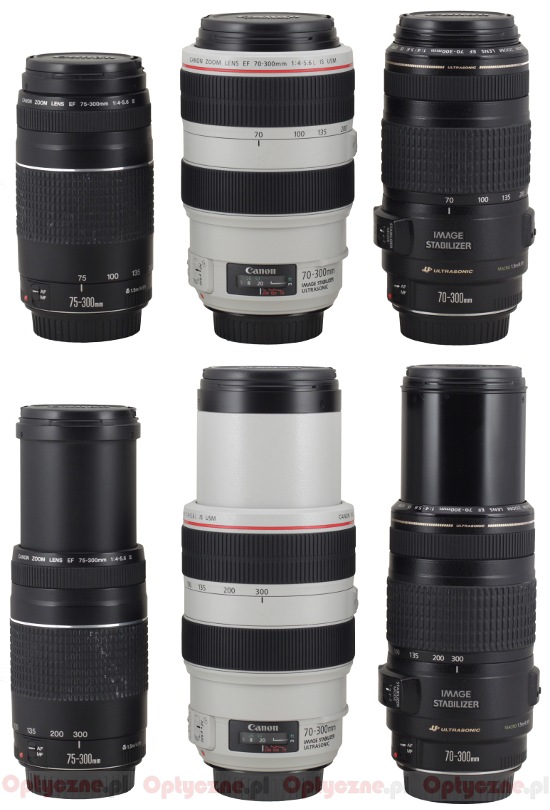 |
Please Support UsIf you enjoy our reviews and articles, and you want us to continue our work please, support our website by donating through PayPal. The funds are going to be used for paying our editorial team, renting servers, and equipping our testing studio; only that way we will be able to continue providing you interesting content for free. |
- - - - - - - - - - - - - - - - - - - - - - - - - - - - - - - - - - - - - - - - - - - - - - - -
The lens starts with a metal bayonet mount with contacts; it surrounds a rear set of elements. The final element is about 3 cm in diameter and, at 70 mm focal length, it hides inside the barrel by less than 1 cm. That value increases to about 2 cm when we pass to the maximum focal length. The inside part of the inner tube, visible from the rear end, is black and matted with black velvet. There are no shiny parts or electronics components visible.
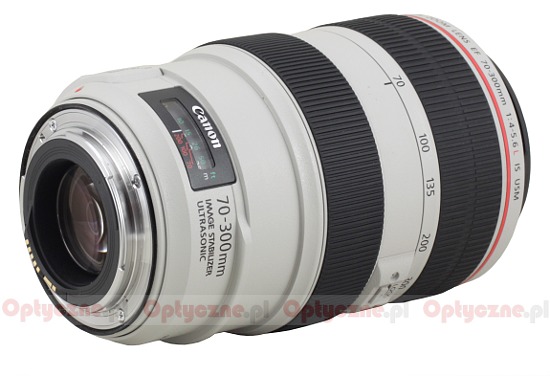 |
Already on a white barrel, made of magnesium alloys, we can find first a red dot used to mark the right place to attach a body, and a distance scale behind a window. The scale is expressed in feet and meters with a clearly marked macro range, although we must admit it has little in common with the proper macro. A shame that Canon failed to provide a bit more in this area because it would be an additional argument for buying this instrument. If the cheap Sigma 70-300 mm APO could focus from less than one meter, giving you a quite decent semblance of the macro mode, Canon could have thought about something similar as well.
On the left side of the distance scale, looking from the top, we get three switches. The first one is used to choose the focusing mechanism working mode (AF/MF), the second one allows us to switch on and off the optical stabilization (STABILIZER ON/OFF), and with the third one we can choose the stabilization mode (MODE 1 and 2).
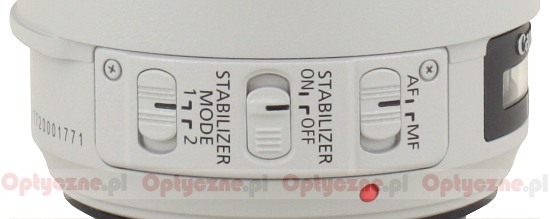 |
The next part of the lens consists of a smooth fragment of the barrel where you can attach a tripod adapter. It is a pity you can’t find the adapter in the lens accessory kit, though.
The next element is a manual focus ring. It is 23 mm wide and rubber ribs are the biggest part of it. It is well-damped and works evenly. Running through the whole scale takes a turn through about 160 degrees.
Then we have a smooth and immobile part of the barrel on which you can find only the LOCK switch, used to block the lens at 70 mm focal length. Its usefulness is limited, though, because the lens is constructed so well that even vigorous shaking can’t make the tube extend on its own.
A zoom ring is the next part of the barrel. It is 43 mm wide and rubber ribbing covers most of it. Below it you can find focal lengths markings for the following values: 70, 100, 135, 200 and 300 mm. Above them you can see a red stripe and the name and the parameters of the lens. When you move that ring the front element system extends on a very stable and almost armoured inner tube. It is really the most solid 70-300 mm class lens we’ve dealt with so far. It looks compact and solid in the folded position and that impression doesn’t change when you extend it; in fact the opposite is true. You can apply significant strength to the extended tube and the system of elements remains all the time in the right position.
The front element itself is 57 mm in diameter and surrounded by a non-rotating filter thread, 67 mm in diameter.
When it comes to the inner construction we deal here with as many as 19 elements positioned in 14 groups. Two elements are made of low dispersion UD glass. Inside the lens you can also find an aperture with eight diaphragm blades which can be closed down to the values ranging from f/32 to f/45, depending on the focal length.
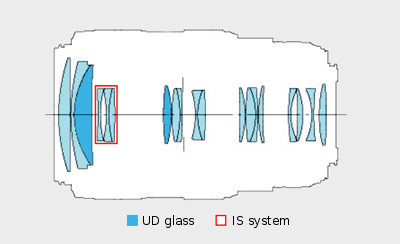
The buyer gets both caps, a hood and a soft pouch in the box. It’s a pity you must buy a tripod adapter separately. With such a high price of the lens it could have been added to the accessory kit.
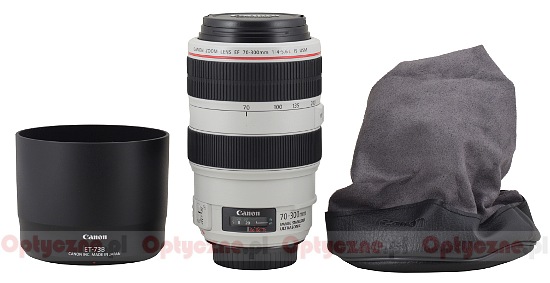 |
Stabilization
For some time now most of producers have boasted of using stabilization as efficient as 4 EV. In our tests so far just one lens didn’t have any problems with reaching (or even slightly exceeding) such a value and it was the expensive Canon EF 70-200 f/2.8L IS USM II. The lens tested here is also a new, pricey construction of the L series so we hoped that its stabilization would be as good as that of the new EF 70–200 mm f/2.8. How did the lens fare in reality? To find out let’s look at a graph, presented below. The test was performed using the Canon EOS 1Ds MkIII and applying 300 mm focal length. For each exposure time ranging from 1/320 to 1/4 of a second we took several dozen photos with the stabilization switched on and off and we determined the percentage of blurred photos. That percentage was then presented as the exposure time function where the 0 EV value corresponds to 1/200 s. on our graph.
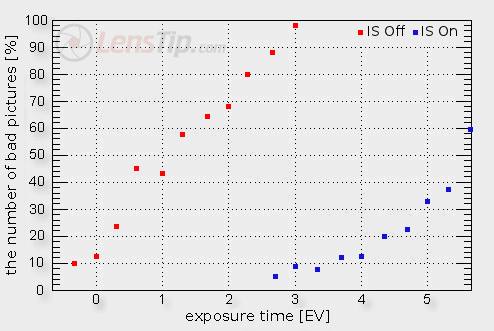
As you can notice, the maximum distance between both curves not only reaches 4 EV but also slightly exceeds that value. That’s why the stabilization efficiency of the tested lens we asses as 4.0-4.3 EV. The result is brilliant indeed– the work with that lens even in bad lighting conditions will be really pleasant. If you got used to the older versions of optical stabilization or sensor stabilization, the achievements of the Canon 70-300 L will impress you without doubt. I was very positively surprised myself seeing how many good quality handheld photos you could take, applying 300 mm focal length and 1/5 s. exposure time.






